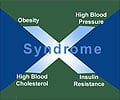A ten-week lifestyle modification program that focuses on high fiber diet can reduce diabetes and heart problems in overweight adults, according to a Brazilian research published in the journal Diabetology & Metabolic Syndrome.
Obesity and cases of overweight individuals has been on a steep rise especially amongst the urban population both in the developed as well as the developing nations. Metabolic syndrome has been identified as both the cause and effect of obesity in India as well the west.Altough Americans have a higher BMI in general, indicators of metabolic syndrome are more prevalent amongst Indians even at a lower BMI. This is because of the higher concentrations of body fat content in the Indian population. The basic indicators of metabolic syndrome include abdominal obesity, hypertension, hypertriglyceridemia (high levels of triglycerides in the blood stream), low HDL concentration and inflammation.
In order to control the epidemic of diabetes and heart problems caused by obesity, there is an urgent call for simpler and executable lifestyle modifications amongst the urban population. A simple lifestyle-change program is more likely to ensure a higher compliance rate thus resulting in better outcomes and control of obesity.
As part of the ongoing research for such programs, researchers from Brazil recently examined a 10-week lifestyle change program aimed at reducing the indicators of metabolic syndrome. The program focused on a high-fiber diet and increased physical activity to reduce the overall factors contributing to metabolic-syndrome.
This pilot study included 22 patients assigned to the general education group and 28 in the high-fiber nutrition group. Dietary counseling and supervised exercise was introduced to both the groups but only the study group (the second group) was introduced to high-fiber intake.
Physical activity amongst these groups included a minimum of three times per week of an 80-minute workout session. This comprised of warm-up, cardio, stretching and strength-training exercises.
The researchers noted that the study group which included a higher dietary fiber intake in the form of fruits and vegetables showed a 24 percent reduction of metabolic syndrome indicators.
The researchers concluded that short term lifestyle change program that included a high-fiber diet led to reduction in the incidence of metabolic syndrome in obese people.
Reference: Mecca, M. S., et al. Ten-week lifestyle changing program reduces several indicators for metabolic syndrome in overweight adults. Diabetology & Metabolic Syndrome 2012.
Source-Medindia














